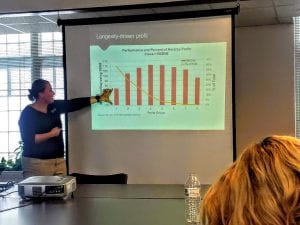Dairy managers from around the SCNY region have been meeting for the past several years each winter, focusing on discussion of topics they have in common. Managers that attend these discussion group meetings tend to be herds that operate freestall facilities and are over 300 milking cows.
Many managers of this group recognize that their heifer inventory outnumbers the amount of heifers they need as replacements. In year’s past, farms were able to sell extra animals to provide added income. But with prices in this market eroding along with milk price, farms that have additional heifer inventory have realized the price they receive upon selling these animals is far less than the cost of raising them. It has also put added culling pressure in the mature lactating herd, as the number of heifers coming in the pipeline is large.
Too much culling in the mature herd can lead to a younger age in the entire herd, which can be problematic from a total herd production standpoint as first lactation cows produce only 85% of a mature cow. This has created a need for herd managers to determine a more defined breeding strategy. In addition to this need, there is also the growing trend of utilizing beef sires to achieve a cross-bred calf that is more valuable at a few days old. How farms can implement this strategy to gain additional income is a key question that herd managers want more information around.
With these needs and issues in mind, this year’s discussion group topics centered on strategies for raising an appropriate amount of heifers for replacements, raising the best genetic quality of replacement heifer possible, and generating more income from the unneeded animals above what they receive for Holstein bull calves currently.
In January, the group heard from invited presenter Dr. Michele Barrett of Zoetis. Dr. Barrett walked the group through strategies for improving herd genetics, which could include genomic testing. The group had varying amounts of experience with genomic testing, and had lots of questions on the different ways to uncover this information and associated risks with using this technology. Because experience differed, members were able to bounce questions off of each other and share their own practices – good and bad.
The second meeting, held in February at Empire Livestock in Dryden, focused on beef cross calves at the sale barn. Invited presenters Hannah Worden and Claire Mulligan of ABS went over their InFocus program, a strategy dairy producers can use to obtain a higher price for crossbred calves. Because of the research and marketing ABS has done, calves that are a result of the InFocus breeding command a premium at the sale barn. Buyers know that calves with blue tags are InFocus calves and will pay above what a normal crossbred calf would bring.
Ken Krutz and Dannielle Cornelius of Empire Livestock Marketing followed up their presentation with actual pricing of calves through the ring from several sale barns, both InFocus calves and regular cross-bred calves. Producers that attended this meeting had ample time to ask both ABS and Empire Livestock representatives more information, and producers stayed well after the meeting was formally ended to continue discussion.
The third meeting, held in March, focused on the breeding strategy of the herd. Jonna Egli of Genex presented to the group the tools they use to help individual herds come up with strategies to utilize conventional bulls, sexed semen technology and beef sires to achieve a desired outcome. This outcome can incorporate growth, genetic improvement and increased income through cross bred calf sales, and can be different for each farm, as well as tailored to changing situations throughout the year.
The group also heard from Dr Mike Baker, professor at Cornell University in Beef Cattle, on market outlooks with cross bred calves as well as costs associated with raising these calves if a producer so chose. Discussion among producers with the presenters helped farms explore the options they could have with different strategies.
Over the three meetings, over 45 people attended – representing 23 farms and 16,810 lactating cows. Since then, many of the farms have contacted their bull studs to request help in formulating a more defined breeding strategy, and several have contacted ABS to request participation in the InFocus program. One herd has asked for assistance from Betsy to finalize their breeding strategy, as it incorporates both herd expansion and utilization of beef sires.
Setting up these strategies takes time, and a cow’s gestation is around nine months, so the direct impact of improved breeding programs and additional income from cross-bred calves is yet to be realized. However, the cost savings of raising only the required number of heifers for replacements is a number that producers will experience as soon as they implement a new strategy. While this cost isn’t a check that they physically write, producers will be able to take some strain off of heifer facilities, maintain forage inventory and start the process for gaining genetic improvement more rapidly. All these things add up to overall profitability that farms need to have in order to be in business.
Going forward, the group has requested more information on where cross bred calves go after the sale barn. The team is looking at partnering with Keystone Mills, a feed company that works with Amish and Mennonite farms in the Finger Lakes region that raise these calves, to set up both a mill tour and farm tour of these facilities this summer to add to the picture of what this emerging production line looks like.

